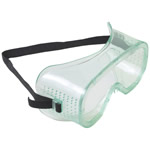 |
PPE for Remediation Workers
According to the NIEHS Guidelines, PPE for remediation workers who handle mold should include:
- Gloves, depending on whether wet work or dry work is performed. Wet work requires that the glove choice be based on the liquid.
- For eye protection, workers should be able to choose either safety glasses or vented goggles.
- Nonporous full-body coveralls.
- Boots.
- Head covering.
- All respirators must be NIOSH certified. The NIEHS Guidelines recommend NIOSH approved, half-face elastomeric respirators with particulate cartridges of at least N-95 for mold remediation workers, unless the environment might include oil mist exposures, in which case a P designation would be needed. Where heavy exposures are anticipated, improving the efficiency from 95 to 100 may be warranted.
Deliver fast and effective Environmental, DOT, and OSHA training with Environmental Training Library. Try it at no cost or risk. For a limited time, also receive a free special report. Download Your Free Report
HVAC Systems
The consensus of the participants in the workshops that produced the NIEHS Guidelines consider the cleaning of mold-contaminated HVAC equipment to be too specialized and requires training beyond what is recommended in the Guidelines. However, representatives from the International Union of Operating Engineers provided a minority opinion that maintenance staff who encounter less than 10 square feet of mold in the ventilation system can be trained to deal with lowlevelHVAC mold. The training should be 8 hours and cover:
- Respiratory protection in accordance with OSHA’s respiratory protection standard (2 hours)
- Proper PPE selection (0.5 hours)
- Area containment to avoid mold from spreading to other areas. How to create a positive or negative pressure with your facility’s HVAC system and the benefits of doing so. Mold suppression methods. Lockout/tagout (1 hour)
- Removal of contaminated material and proper disposal, including a discussion on the variety of biocides used by HVAC manufacturers (0.75 hours)
- Final area cleanup using a HEPA vacuum and cleaned with a damp cloth and/or mop with a detergent solution (0.75 hours)
- Areas left to dry and visibly free from contamination and debris (0.5 hours)
- Prevention discussion on the causes of HVAC contamination, humidification, dehumidification, and condensation (1.5 hours)
- Performance-based test (1 hour)
Download your FREE special report, Hazwaste Container Management: Where EPA Inspectors Look First, and receive a 30-day trial of Environmental Training Library at no cost or obligation. Download Your Free Report
If written verification is available that a worker has attended and successfully completed a 40-hour HAZWOPER, an OSHA 500, or an OSHA 501 course, it is recommended that the training be reduced to 4 hours.
Training: it’s hard work, and it can take so much time! Let BLR’s environmental experts do the work for you with Environmental Training Library. This extensive library of prewritten training materials helps you deliver EPA, RCRA, and HAZWOPER required training with ease.
In the start package along, you’ll have 120 training tools for your first 20 sessions. This includes PowerPoint training meetings with audio, interactive classroom exercises, handouts, quizzes, and more! And with your regular supplements, (included at no additional cost) you’ll get 2 new PowerPoints each quarter to keep your training current!
Take a Free Trial today, and for a limited time, also download our Free Special Report, Hazwaste Container Management: Where EPA Inspectors Look First.
